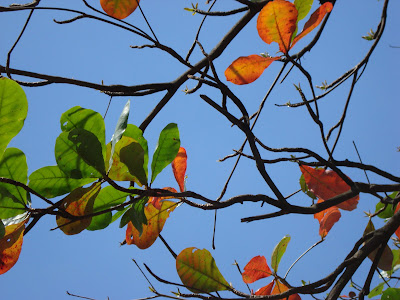A night of nature's music in a garden
Dr Abe V Rotor
Written at the former Eco Sanctuary of Saint Paul University QC.
 |
| Long horned grasshopper or katydid (Phaneroptera furcifera) |
Since childhood I have always been fascinated by insect music. Stealthily, I searched for the singer. I found out that these insects are ventriloquists and a slight turn of their wings or bodies would deceive the hunter. And when I succeed and get nearer and nearer to the source of the music, the singer would abruptly stop.
Then I finally succeeded in pinning down with a flashlight the little Caruso in the middle of his performance. He is well hidden behind a leaf, brown to black, compact and sturdy, nearly two inches long, with a long tail and a pair of antennae. His front wings are raised 45 degrees above his abdomen on which the hind wings are folded. This is the cricket’s fiddling position. Now he rubs the two leathery wings against each other in a back and forth motions, a process called stridulation, which inspired man to invent the violin. On closer examination the base of the front wing in lined with a sharp edge to form the scrapper, while the ventral side has a file like ridge, the file, which represents the bow of the violin.
And what about the stereoscopic sound effect? A pair of tympana, which are drum-like organs, found at the base of the front tibia, are actually ears which, together with the raised wings, serve as resonator, sending the sound to as far as a mile away on a still night.
Now let us analyze the music produced - or is it only a sound that is mistaken for some music qualities? The cricket's sound produced by a single stroke called pulse. Each pulse is composed of a number of individual tooth strokes of the scraper and file. Pulse rate is from four to five per second, but on warm summer night the rate becomes faster. Thus, crickets are not only watchdogs (they stop when they sense an intruder), they are also indicators of temperature – and perhaps the coming of bad weather. It is for these reasons, other than their music, that the Chinese and the Japanese love them as pets.
The pulses of cricket are relatively musical; that is, they can usually be assigned a definite pitch, varying from 1,500 to 10,000 hertz, depending on the species. Those of the long-horned grasshopper or katydid are more noise-like; that is, they contain a wide band of frequencies, including clicking and lapsing, and cannot be assigned to a definite pitch. The monotony of its sound must have led to the coining of the insect’s name, katydid-katydid-katydid…
There are three musical pieces the cricket plays. Calling songs are clear crisp, and loud, which, of course, suit the intention. When a female comes around and nudges the singing male, his music becomes soft and romantic, lasting for many minutes to hours, and he forgets his role of warning the presence of an intruder or telling of the coming storm. Anyone who is love-struck is like that, I suppose..
But worse can come all of a sudden. This sentinel falls silent as he takes the bride. And when another suitor is around, this Valentino takes a fighting stance and sings the Bastille, a battle song.
I came across studies on insect music. I began to take interest, imitating it with the violin. It is impossible and the audiospectrogram tells why. You cannot deceive them and break their code of communication. Nature is specific: only the members of the same species understand one another. And no two species can communicate vis-à-vis this auditory means. This is one area in development biology, which has not been fully explored. How did this mechanism of species communication evolve? With computers today, can it be explored as an alternative and safe means of controlling destructive species?
The garden meets sunrise with fluttering butterflies, so does a garden surrender into the night with an array of concerto and orchestra music, and becomes a place for meditation. I say that the music produced by this insect is a sound of peace and praise for life. When the students have gone home and the offices already closed, I usually spend hours waiting for my color-coding time at the SPCQ garden. The chores of the day vanished easily, and I found the evening so relaxing that I did not complain of the traffic on my way home.
The great Charles Darwin himself expressed his deep feelings for these night’s musicians in his book, Cricket at the Heart. He said, “I love it for the many times I have heard it, and the many thoughts its harmless music has given me.”
 |
| Field cricket (Acheta bimaculata) |
As for me, I still find peace in the garden with these humble companions in the night. ~



























